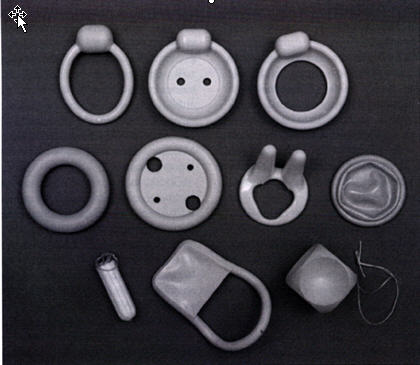Bladder Leakage
Bladder Leakage Is A Nuisance!
I have a very dear friend who has struggled with bladder leakage for years. Every time that she stood up, she darted quickly for the porcelain convenience, no matter where we were! She made more quick trips to the Ladies Room than we could count on our fingers and toes. Because of her urinary distress, trips to the mall were planned around the location of the nearest bathroom. Her sleep was often interrupted during the night because of numerous treks to the potty. Something had to be done! She needed an answer for her problem! This article may help those who struggle with bladder leaks.
My friend's Primary Care Doctor suggested surgery to correct bladder leakage and allow the urinary system to work properly. My friend is not a candidate for surgery because of health issues. What to do?
Female Doctor to the Rescue
My friend found a female Doctor that was open to alternate means of treating her bladder symptoms! After an examination, she was in agreement that a pessary might be the answer to the long term leaky bladder symptoms. This gracious Doctor shared charts and information about this device that left us feeling educated and hopeful for the next visit.
A few days later, my friend and I revisited the doctor's office. The second pessary fitting was just the right size and provided immediate relief. A followup appointment a few days later proved that it was working and the results were satisfactory. In three months, there will be another visit for the cleaning and replacement of the pessary!
The end result is that this friend has experienced significant changes in her ability to retain liquids and refrain from leakage. The trips to the bathroom are minimal and the freedom of not running to every available bathroom is life changing. She has gotten used to the pessary and there is no pain or discomfort from wearing it!
What We Learned From The Doctor
After years of dealing with this problem, why didn't at least one Doctor tell my friend about the pessary? The only suggestion presented was surgery. The pessary is inexpensive, surgeries are expensive. It is about money and education. Some doctors are not familiar with this simple means of helping women. That is why I am writing this hub, women need to know about the pessary!
An Example of a Pessary

The Pessary
The Pessary is a small plastic, latex, or silicone-based medical device inserted into the vagina or rectum to hold the pelvic floor muscles in place. It is used to support the uterus, vagina, bladder or rectum. It is a removable device placed into the vagina to support areas of organ prolapse. There are four conditions that are often treated with the pessary.
Cystocele - refers to the bladder falling down
Rectocele - refers to the rectum falling down
Enterocele - refers to the small intestine falling down
Vaginal Prolapse - refers to the toop of the vagina falling down
The pessary is a safe and useful treatment alternative for a number of gynecological conditions. It is most often used to treat prolapse of the uterus. Prolapse means that your uterus droops or sags into the vaginal canal because muscle ligaments that should support are weak.
Bladder leaks, urinary incontinence, or stress incontinence, is the involuntary leaking of urine when coughing, straining or exercising. The pessary works by applying pressure onto the urethra (which drains the bladder) against the pubic bone and lifts the lower part of the bladder. It can be placed temporarily or permanently. It must be placed by a Physician.
More Pessary Information
The health professional will fit the pessary to hold the organs in position without causing discomfort. These devices come in a variety of sizes and should be fitted carefully. The pessary is fitted in the Doctor's office. It may take several attempts to find the one that works best and feels and fits just right. The Doctor will teach you how to remove, clean and reinsert the pessary on a regular schedule. The cleaning schedule is determined by the type of prolapse and the type of pessary. If cleaning and reinserting the pessary is too difficult for you, the Doctor can do it in the office.
There are several types of pessary. The ring pessary is used more than the others. The donut pessary, the inflatable pessary and the cube are also used, depending on the need and degree of support required.
The pessary is also used when symptoms are mild or when a woman is still in her childbearing years. They are also used in women with healthy problems that are not candidates for surgery.
The pessary is not a cure for the pelvic organ prolapse, but they do help to manage and slow the progression of prolapse. They add support to the vagina and increase tightness of the tissues and muscles of the pelvis. Symptoms improve in many women who use a pessary and in some women, all symptoms are alleviated.
Is it safe?
The pessary is said to be an extremely safe device. It has stood the test of time. A pessary may greatly improve the quality of life for women.
When the pessary is removed, the health professional should check for any irritation, pressure sores, or allergic reactions. Regular cleaning reduces the risk of complications.
Having to change the size of the pessary at least once is not unusual. The largest pessary that can be worn is usually the most effective. A pessary is fit by trial and error. Visits for an initial follow up are usually one to two weeks for the first time and every two to three months thereafter.
In post menopausal women, estrogen is often used in the form of a cream, ring or tablets to help with irritation that might be caused by the pessary.
Is A Pessary Right For Me?
One survey that was done showed that 22% of women over 18 have registered some complaint of symptoms related to prolapse. Good candidates for a pessary include a pregnant woman, an elderly woman where surgery is risky and a woman when previous surgery for incontinence was unsuccessful. It can be used for women who only have symptoms for stress incontinence with vigorous exercise.
From my readings, prolapse is epidemic in post partum women in their twenties and thirties. Christine Kent, R.N., author of Saving the Whole Woman, indicates that this is a very common problem. More than half of women will experience some form or degree of pelvic organ relapse during their lifetime.
The pelvic organ, including the bladder, uterus, and rectum are held in place by several layers of muscles and strong tissues. Weakness in these very muscles and tissues can lead to prolapse. Multiple vaginal deliveries can weaken the tissues. Hysterectomies or other pelvic surgeries, chronic constipation, chronic coughing, or repetitive heavy lifting can contribute to this weakness.
In Conclusion
You won't read about a pessary in the news. It isn't a quick fix and it is inexpensive compared to surgery. If you struggle with incontinence, find a Doctor who knows about the pessary. It is effective and may eliminate your symptoms!
Bladder Information
- What Does The Bladder Do?
The urinary bladder is a balloon-shaped organ which stores urine excreted by the kidneys. It is located on the pelvic floor, and in an adult can hold over a pint (0.6 litres) of urine. Urine passes from...
More Information Available on the Pessary
- The Whole Woman
- HealthEWoman ~ Heal The Woman Facts Plus Stories Equals Knowledge
integrating medical facts with medical knowledge to increase understanding, empower patients, and foster sustainable healthcare - familydoctor.org Home -- familydoctor.org
Award-winning, trustworthy, and credible health information and tools for patients from American Academy of Family Physicians. - WebMD - Better information. Better health.
The leading source for trustworthy and timely health and medical news and information. Providing credible health information, supportive community, and educational services by blending award-winning expertise in content, community services, expert co









